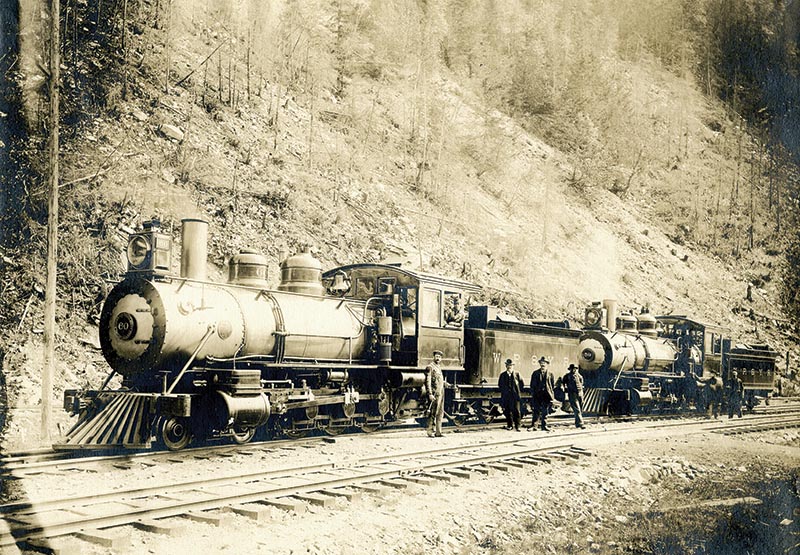So far in my series, I have covered the first six locomotives that the Pacific Contract Company (PCC) bought second-hand during construction, and the first two new locomotives the White Pass & Yukon Route (WP&YR) bought. The PCC started construction in May of 1898 and steady progress was made. The first eight locomotives were kept busy hauling construction, freight, and passenger trains north from the boomtown of Skagway, Alaska. The future must certainly have looked bright to the investors and management of the company in late 1899 as they were only seven-months or so from completing the first 110 miles. The company had ordered a pair of new locomotives from Baldwin Locomotive Works the year before (numbers 6/56 and 7/57, see the September/October 2022 GAZETTE).
The White Pass & Yukon Route starts in Skagway, Alaska and winds its way up the Coast Range Mountains. The grades approach 4 percent on the way to the summit twenty miles away. These first twenty miles were the test of a locomotive’s capabilities on the White Pass. From White Pass summit, ninety miles north to Whitehorse, Yukon Territory, the line is relatively level except for the final drop into Whitehorse. None of the initial second-hand power was well suited for these steep, wet rails. Additionally, consolidations 6/56 and 7/57 with their 38-inch diameter drive wheels while capable of handling the grades, were probably not capable of the sustained speed desired north of the summit. In December of 1899, they went back to Baldwin for more motive power.
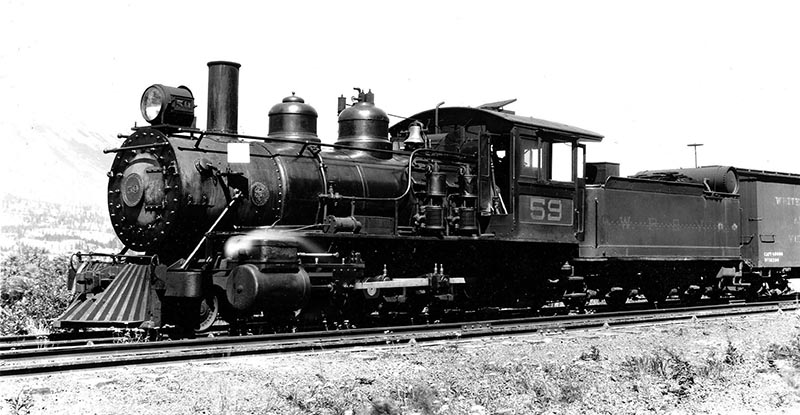
ABOVE: WP&YR 59 poses at Lake Bennett, Yukon Territory. She has the snowplow brackets on her smokebox, dual air pumps, modified tender flair with large air tank, and electric lights. This photo dates to July 1928 making the engine 28 years old already. —Photo courtesy Railroad Museum of Pennsylvania (PHMC), negative 33678, Rob Bell collection.
An order for four locomotives was placed with Baldwin on December 8, 1899. The first two were outside-framed, 4-6-0, ten-wheeler type engines, Baldwin class 10-28D. These two were construction numbers 17749 and 17750, numbered 59 and 60 respectively. Built in May of 1900, both had 58-inch diameter boilers, 17- x 20-inch cylinders, 42-inch diameter drivers, and carried about 75,000 pounds on their drivers when in working order. They used a deep-square (DS) firebox style set behind the three driving axles. These specifications yielded a tractive effort of 21,100 pounds. In later D&RG terminology, they would have been classed a T-21, (T for ten-wheeler and 21 for 21,000 lbs. tractive effort).
Evidently, numbers 59 and 60 handled the steep grades and sharp curves between Skagway and the summit well enough. Longtime WP&YR engineer J.D. True reported that these engines could handle 120 tons each up the grade out of Skagway. In addition, they had the needed speed for the north end of the line. The WP&YR must have been quite satisfied with the performance of these ten-wheelers, as they ordered two more nearly identical engines in November 1900.
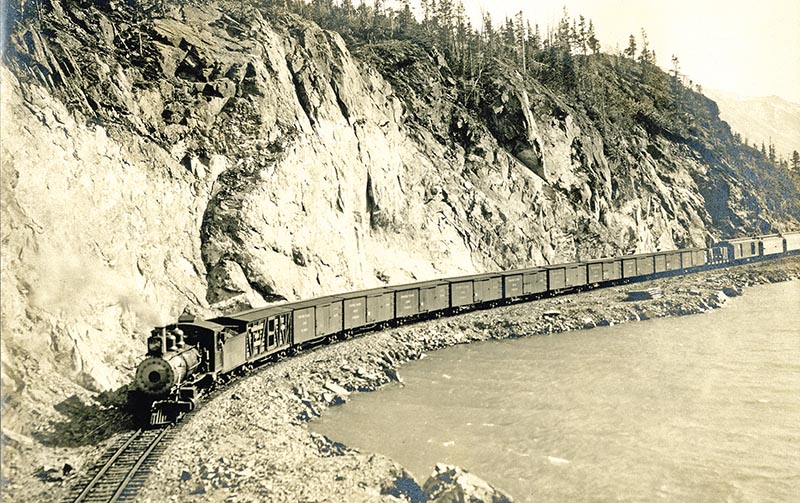
ABOVE: Either WP&YR 59 or 60 hauls a mixed train along the shore of Lake Bennett consisting of 1 stockcar, 10 boxcars, 1 flatcar, 1 baggage car, and at least 2 coaches. This photo shows the size of train that these locomotives could handle. This is a relatively early photograph as the locomotive has the snowplow brackets, but only a single air pump. —Photo by Case & Draper, Skagway Museum, Talbot-035
Numbers 66 and 67 were built in May of 1901 with construction numbers 18964 and 18965 respectively. The subtle differences between 66/67 and 59/60 included smooth domes and an additional sand dome just forward of the cab, necessitating the bell be mounted forward of the steam dome.
These four locomotives are referred to as the 59-class and were the backbone of the WP&YR fleet for over thirty-five years. They handled freight, passenger, maintenance-of-way, and mixed-consists from tidewater to the interior of the Yukon. Within a short time, all four locomotives had brackets permanently mounted to their smokeboxes for the attachment of snowplows. They also had flangers attached to their four-wheel pony trucks in winter. The next change to these locomotives was the addition of a second air pump to each engine. Following this were modifications to the rear tender flairs and larger air reservoirs being installed on the rear tender decks. All four of these locomotives received electric headlights in 1919. For this to be accomplished, steam powered dynamos (generators) were mounted on top of the boilers just in front of the cabs. On the 66 and 67 this necessitated the removal of the rear sand dome.
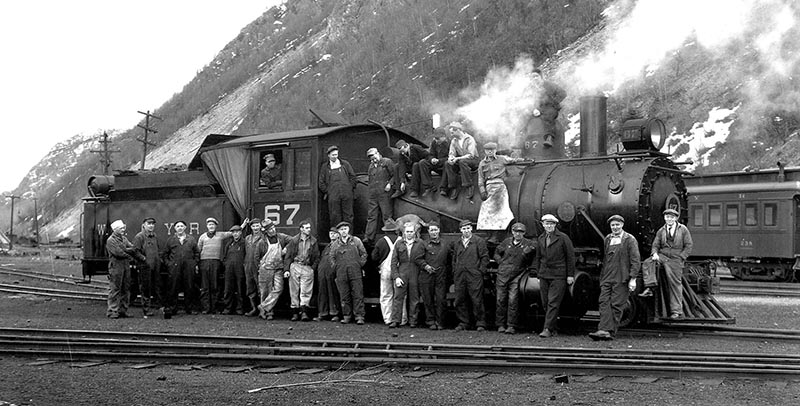
ABOVE: WP&YR #67 poses with the shop crew and shop dog (middle of the running board), probably sometime in the 1920s or 1930s. The locomotive is all dressed up for winter except for her plow. During the winters, the White Pass installed cab curtains on the cab and coal boards on the tenders to cover the coal to keep snow and ice out. Winter temperatures often reached 30 to 40 degrees below zero. —Photo courtesy the Skagway Museum, Dedman Collection DPC-1498
On February 12, 1932, the original Skagway roundhouse burned to the ground. Several locomotives were in-side at the time and 59 and 67 burned in the fire. The WP&YR shop crew rebuilt both and they stayed in service until both were retired in 1940. Number 59 was scrapped that same year. Number 67 evidently lasted on the property until 1951 when she was used as riprap in the Skagway River.
Number 60 was involved in a collision in late February of 1938 that required repairs to the pilot beam, flangers, and brake rigging. Number 60 may have been retired sometime late in 1942, but was certainly declared unserviceable in 1947 and written off. She and her tender were dumped in the Skagway River as riprap in 1949. Both were exhumed from their burial in the riverbank in 1990 and left on their sides near the shops, while No. 60’s tender was moved adjacent to the Skagway Museum. No. 60 was pulled back upright in 2003 but remains near the shops at this time.
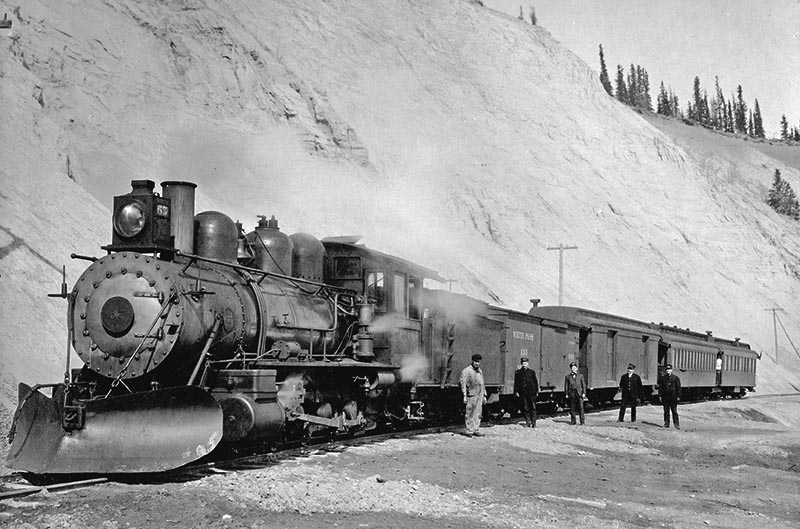
ABOVE: WP&YR 67 with her plow, box headlight, and three smooth domes pauses with a boxcar, a baggage car and 2 coaches. We know this photo is early as she only has one air pump. One interesting detail is the early installation of a side ladder on the tender. The shops installed these when they installed the coal boards for winter operation. This is the earliest use of this type of ladder noted by the author to date. Their use carried over to the permanent installation of steel side ladders when the WP&YR converted its last steam locomotives to burn oil in 1951. —Photo by E.J. Hamacher, courtesy the Skagway Museum, Talbot-022
On August 12, 1905, the Whitehorse Star newspaper reported that No. 66 went thirty feet down the mountainside at mile post 17 on account of a washout. A crew built a temporary track down to the locomotive, righted it, and pulled it back up to the line. Number 66 served the railroad the longest of the four as she was not retired until 1952. Her original tender was wrecked in July 1947 and No. 66 received the tender from WP&YR 62. In 1951, the tender superstructure from No. 69 replaced that of the ex-62’s on the tender frame. Finally, in 1967 White Pass & Yukon Route No. 66 was unceremoniously dumped in the Skagway River as riprap like two of her sisters.
Outside frame ten-wheelers were not known in the continental United States. They were, however, quite popular in Central America. The Oahu Railway in Hawaii had five as well. Most of these ten-wheelers did not share the deep-square firebox style. The four 59-class locomotives of the White Pass & Yukon Route were the line’s main motive power for almost forty years. Even with the arrival of the first two WP&YR 70-class 2-8-2 locomotives in 1938 and 1939, the 59-class hung on for quite a few more years. It was not until several years after the arrival of the third and fourth 70-class locomotives in 1947 that the last of these 4-6-0s would be retired. Given their longevity, the success of these outside-framed ten-wheelers on the White Pass & Yukon Route cannot be argued.
A correction to a previous article needs to be addressed; in part 2 of this series the arrival date of locomotive number 3 was not known. I have since learned that locomotive numbers 1, 2, and 3 all arrived in Skagway together on July 20, 1898 — information is still to be discovered now and again. As always, I would like to acknowledge Boerries Burkhardt, David Fletcher, Robert Hilton, Chuck Morse, Bruce Pryor, and John Stutz for their assistance and information. In Part 7, I will examine another of the White Pass & Yukon Route’s locomotives, one that is currently being resurrected, accompanied by another of David Fletcher’s drawings.


